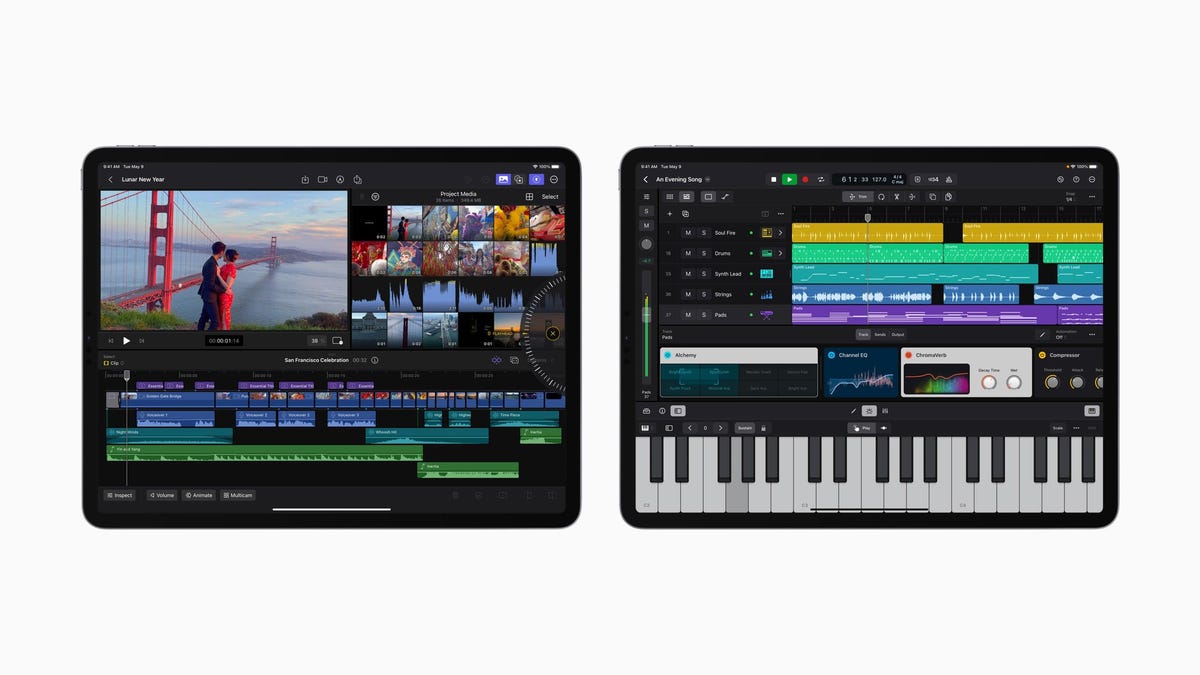You Can Finally Use Final Cut Pro and Logic Pro on Your IPad

From time to time, Apple really surprises me. Today is one such moment : the company has just announced the release of Final Cut Pro and Logic Pro for iPad, and with them the tools to create professional video and music using a touch screen device. These are apps made for the iPad and not straight ports of their macOS counterparts, for better or worse. Let’s dive into this.
Part of the appeal of both apps is their versatile approach. Theoretically, you could create a video or music project with Final Cut Pro or Logic Pro using only your iPad: use the device to record video and then edit in FCP, write music using the on-screen keyboard, record audio using the internal microphone, and mix it all together in Logic. Of course, higher quality projects will require additional hardware, but it’s now theoretically possible to do something from start to finish using just an iPad and one of these apps.
Of course, the secondary attraction is the ability to interact with your professional applications with a touch rather than a keyboard and mouse. You can still use your keyboard, but if you’ve been dreaming of editing movies and music with your hands, you can finally do it.
What to expect from Final Cut Pro for iPad
The biggest change that editors will need to get used to when running Final Cut Pro on their iPads is the jog wheel, which appears to be designed to replace the scroll wheel on a mouse. By turning the jog wheels, you can move through the timeline, adjust clips, and make changes. It will be interesting to see how the rotary switch affects experienced editors and whether it speeds up workflows.
Another iPad-only feature of Final Cut Pro is Apple Pencil support. This is the first time you can interact with the Final Cut timeline with a pencil, allowing you to draw or write on your videos. There’s also a so-called “pro camera mode” that lets you capture video from your iPad using professional camera controls, including audio levels, recording time, focus, exposure, and white balance. If you have an iPad M2, you can shoot in ProRes.
Otherwise, it seems to be the Final Cut Pro we all know. You have access to editing tools such as multi-camera video editing, graphics, visual and sound effects. Apple highlights tools like “Scene Removal Mask” that removes the background even without a green screen; Auto Crop, which corrects your video to get the correct aspect ratio for your project; Voice isolation that removes background noise from your audio.
You can also transfer projects between iPad and Mac, so you don’t have to be tied to the same device to do all the editing.
What to expect from Logic Pro for iPad
For starters, Logic Pro for iPad has a brand new audio browser. You can check instrument patches, audio patches, plug-in presets, samples and loops in the sidebar and then listen to them to see if they suit your project. If one works, drop it!
Apple advertises over 100 instruments and effect plugins that come with Logic Pro. Play instruments right on the iPad display, especially useful for keyboard or drum parts, and mix and match instrument sounds to find the right one. A new plug-in called Beat Breaker allows you to use Multi-Touch to change the sound. You can use the Quick Sampler to completely turn a particular sample into a new playable instrument. Create your own drum beats with the Step Sequencer and Drum Machine Designer.
One thing I’m particularly excited about is the mixer: it seems too fun to adjust the volume faders, adjust the pan, and change plug-ins using the touch screen. It will be interesting to see if Logic Pro is even more useful with Multi-Touch than Final Cut. Just like with Final Cut Pro, you can transfer projects from iPad to Mac and create soundtracks for use in Final Cut on iPad.
Pricing and Compatibility: You’ll Need a Newer iPad
Unfortunately, you’ll have to pay for both of these apps to use them on iPad, even if you bought them before. While Apple charges $199 for Logic Pro for macOS and $299 for Final Cut Pro, the iPadOS versions of each are subscription-based, with no option to buy them directly. Apple doesn’t offer a free version or even a discount for those who have purchased macOS apps, which is disappointing.
However, the subscription prices aren’t all that bad. Apple is asking $5 a month for an app, or $50 a year. This includes a one month free trial for new subscribers, which is all of us at the moment. I’m definitely going to try both for the first month and then see if I find one or both useful enough to justify paying. Both apps will be available on the App Store on Tuesday, May 23rd.
It seems that Final Cut Pro is a more demanding application as its system requirements are slightly higher than those of Logic Pro. Apple’s professional editing app is only available on the iPad M1, while Logic Pro is available on the A12 Bionic and later. It’s a bummer because there are plenty of iPads out there that are powerful enough not to need an update but still won’t be able to run Final Cut Pro, especially the iPad Pro A12Z.
What’s not yet clear is whether these apps live up to their Mac counterparts or if they made any sacrifices along the way to iPadOS. Apple didn’t say much in its press release, so it all comes down to real-world testing to see how they perform.